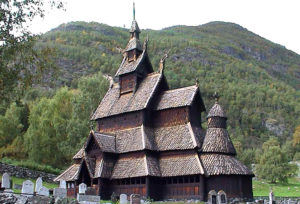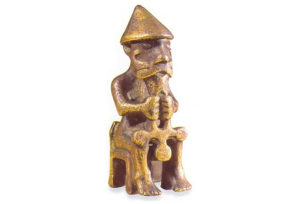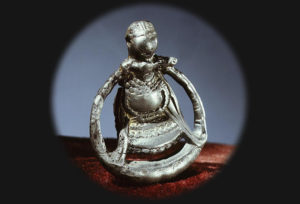Mythology in general
 The viking people were christianized relatively late (11th century), so they had a long tradition of worshipping their own mythological deities. Their myths represent different characters, besides the deities themselves, like giants, dwarves, trolls, elves, snakes, dragons etc. Furthermore, the power of controlling magic was not just of gods, for example shapeshifting, returning dead to life. Beside them, giants, as well as even certain humans, had the power of taking animal forms.1
The viking people were christianized relatively late (11th century), so they had a long tradition of worshipping their own mythological deities. Their myths represent different characters, besides the deities themselves, like giants, dwarves, trolls, elves, snakes, dragons etc. Furthermore, the power of controlling magic was not just of gods, for example shapeshifting, returning dead to life. Beside them, giants, as well as even certain humans, had the power of taking animal forms.1
The folks made no difference between religious and secular world in their god worshiping. There were no priests in the viking world, nor even places, such as temples, to worship the gods: „Instead, religious beliefs were inwrought in everyday life, and the ceremonies were often served in the open. Kings, dukes and other dignitaries presided seasonal ceremonies during which the entire communities showed their support to gods. Nevertheless, many ceremonies of worship unwound in an improvised fashion in informal and more modest surroundings, such as house or similar property.2
Divine families – Aesir and Vanir
In the Viking world, there were two families of deities – Aesir and Vanir. They were at war for a very long time, but since neither family was able to win the war, they concluded a truce.
The Aesir family was greater in number, its members lived in Asgard, and were generally considered gods of war. Most common of the Aesir were the supreme god Odin, his eldest son Thor, along with Baldur, who was the favorite among gods, the war god Tyr, and Loki, who wasn’t really a god, but lived by their side in Asgard.
Members of Vanir were gods of welfare, health and fertility. More notable of them were god of the sea Njord, his twin son and daughter Frey and Freya, who was the goddess of love and beauty, Frigg (or Hlin), Odin’s wife who was a mother to many gods, Henir (Ve) and Lodur (Vili), Odin’s brothers who helped him create the world and the people, and Ull, god of winter.
Odin
Odin is the supreme Viking deity. He was the „father of everything“, one of the creators of human kind, even a father of some gods. His trademark was a spear with magical powers, Gungnir, which would infallibly hit every target. His horse was Sleipnir, which had eight legs, and was the best of its kind. He was also accompanied by two ravens, Huginn (Thought) and Munin (Memory), that flew around the world, and reported back everything they would see.3
He was also the supreme god of war: „As such, he was the protector of the aristocratic warrior class, especially of the royal houses in Denmark and Norway. Apart from that, he was an inspiration to the wild Norse warriors, followers of Odin who cherished combat frenzy as a method of intimidation. His name itself, meaning „furious“ or „drunk“, shows the characteristics they were keen on showing. Odin was the proprietor of Valhala, the Hall of the dead, where the warriors who fell in combat were taken off the battlefield.“4
From his throne on the mountain Hildskjalf he watched over nine worlds, and sometimes wearing a disguise, he walked among people, showing himself as a tall man, grey-bearded, in a long cloak and wearing a wide brim hat.5
He regarded knowledge as a valuable power, and often sacrificed himself to get to it. He was a god of poetry, who stole Mead of inspiration from its guardian, a giant called Suttung. He learned the secret of the runes hanging from the Tree of the world for nine days and nights. This is associated with his ability to raise hanged people from the dead, for which he was also known as „The Hanged One“ or „The Master Of Gallows“. He had only one eye, because he sacrificed the other one in exchange for drinking from the Well of knowledge.6
Thor
 The strongest among gods, protector of order, divine thunderer, inseparable from his hammer, Thor aroused most admiration of all of the gods. His cult spread through all of Viking world, and the fact that one quarter of all Icelandic names from the Viking period contained the word Thor speaks well of his popularity.7 His day was Thursday, which is also derived from his name. He was a fierce enemy of giants, and was honored as the protector of Asgard and Midgard.8 He was a son of Odin and Jord, and he lived with his spouse Sif.
The strongest among gods, protector of order, divine thunderer, inseparable from his hammer, Thor aroused most admiration of all of the gods. His cult spread through all of Viking world, and the fact that one quarter of all Icelandic names from the Viking period contained the word Thor speaks well of his popularity.7 His day was Thursday, which is also derived from his name. He was a fierce enemy of giants, and was honored as the protector of Asgard and Midgard.8 He was a son of Odin and Jord, and he lived with his spouse Sif.
His most valued possession was his hammer, Mjöllnir.9 It would smash anything it hit, afterwards returning to Thor’s hands.10 He also had a magic belt that increased his strength by half whilst worn. He traveled in a chariot towed by two goats, Tanngrisnir and Tasnngnjostr, which had the magical power of regeneration.
He was related to natural forces, primarily storms, thunder was thought to be the noise from his chariot passing through the skies. Travellers put themselves under his patronage when going on a journey.
Most of village populace considered him the supreme deity to whom they would turn for help when in danger.
Loki
Loki was the master of mischief, vicious and cunning, a trickster predetermined to turn to a symbol of true evil at the hour of the final conflict at Ragnarok.11 He was able to shift his shape and gender. There are different theories about his origin: „Most probably he was a son of a giant; he was granted entrance to Asgard by gaining Odin’s friendship – the two of them became blood brothers.“12
His descendants are also followers of the forces of evil, his children with the female giant Angrboda were: Hel – queen of the dead, Snake of the World Jormunganda and voracious wolf Fenrir. The latter two will, along Loki, play important roles in Ragnarok as followers of evil.
Freya
 She was the goddess of love, birth, death and fertility, viz the whole human life cycle.13 She liked luxury and beautiful items: „and it’s also well-known that she wasn’t too shy in choosing methods to collect them – for example, she agreed to sleep with four dwarves in exchange for the priceless necklace Brisingamen“.14 She was also regarded as embodiment of sexual desire, and was worshipped for her passionate nature, wherefore Loki accused her of sleeping with all gods, even her brother.15
She was the goddess of love, birth, death and fertility, viz the whole human life cycle.13 She liked luxury and beautiful items: „and it’s also well-known that she wasn’t too shy in choosing methods to collect them – for example, she agreed to sleep with four dwarves in exchange for the priceless necklace Brisingamen“.14 She was also regarded as embodiment of sexual desire, and was worshipped for her passionate nature, wherefore Loki accused her of sleeping with all gods, even her brother.15
It was said that she wept golden tears, so she was also called „Goddess beautiful in tears“. She was called upon by lovers, but also by women in labour. However, she had a coarser side: „Sometimes she hunted on the battlefields, sharing half of slain warriors with Odin and admitting the ones she had chosen to her palace Folkvanger.16
Other creatures
Beside gods, there are many other fantasy creatures in Viking mythology, like:
Giants
Giants are mostly mentioned as the enemies of gods, although their relationships were not entirely hostile. There are numerous stories of affairs between gods and giants, ie. even Thor was born from Odin’s relationship with Jord, who was a female giant.
In myths, they are generally displayed as slow and boring, awed mostly for their monstrous size, which was greater even than gods’. Once in a while they even displayed a kind nature. Since they were creatures of cold and dark, they would have turned to stone if touched by sunlight.
Dwarves
Dwarves were always considered great craftsmen, having built all of the treasures and magical items gods possessed. They lived in mountain caves, beneath the ground, and, much like the giants, didn’t like the sunlight. They were generally friendly to people.
Trolls
They were underground creatures as well, although later folk tales mention that the mounds in which they lived had openable tops through which the sunlight came inside. They often worked as giants’ servants.17
Elves
Their characteristics were very contradictory: „elves of the light were considered almost as beutiful as gods, whilst the elves of the dark were malformed and disgusting. Reminiscence of both traditions remained in the folklore at later ages, in the form of fairies and goblins.“18 House owners would, within the fertility ceremony, offer them sacrifices at the beginning of winter.
Valkyries
The Valkyries were beautiful girls Odin sent to the battlefield to choose warriors that will die. Half of them would then belong to him, and the other half to Freyja. They decided who would win the battle. They also served the warriors in Valhalla.
Snakes
In Viking myths, the snakes had generally negative connotation, and because they lived underground, they were also considered to be related to the dead. Even though they had no mythical role, snakes were often confused with dragons. They were a threat to the Tree of the world, which was described in ancient rhymes.
The most terrifying of all the snakes was the Snake of the world, Jormungand. „It was one of the three monstrous children of Loki and the female giant Angrboda. Odin threw it in the sea, for he had a vision of great evil the creature would bring at the hour of Ragnarok. There, it grew until its body was long enough to twine around the world and it could reach its own tail with its mouth.“19
Dragons
 Although snakes aroused fear, dragons were far more dangerous and dreadful. With their fire breath they could incinerate anything in their way. Their shells were impenetrable to swords and arrows, and the only vulnerable area of their skin was the abdomen. They lived in bronze-age tumuli, which were the size of small hills. Due to their affiliation to the underground, they also came out only after sundown. Their role in mythology was guarding treasures, for which Tony Allan claims to be: „reflection of real piles of precious sepulchral items often found in tumuli which were considered dragon lairs.“20
Although snakes aroused fear, dragons were far more dangerous and dreadful. With their fire breath they could incinerate anything in their way. Their shells were impenetrable to swords and arrows, and the only vulnerable area of their skin was the abdomen. They lived in bronze-age tumuli, which were the size of small hills. Due to their affiliation to the underground, they also came out only after sundown. Their role in mythology was guarding treasures, for which Tony Allan claims to be: „reflection of real piles of precious sepulchral items often found in tumuli which were considered dragon lairs.“20
- Vikings were Christianized relatively late (11th century), so their mythology was developed through a long period of time.
- In Viking society, there were no temples, nor were there any people with clerical roles. Religious and earthly worlds were extremely interconnected.
- In the Viking world, there were two divine families – Aesir and Vanir.
- TONY ALLAN, Vikinzi, Duncan Baird Publishers Ltd, 2001.
- 1 Vikinzi, 100
- 2 Vikinzi, 93
- 3 Vikinzi, 42
- 4 Vikinzi, 45
- 5 Vikinzi, 42
- 6 Vikinzi, 136
- 7 Vikinzi, 51
- 8 Vikinzi, 50
- 9 It is one of the six treasures dwarves have crafted for the gods: Odin’s spear Gungnir, his ring Draupnir, presents for Frey: wild boar with golden mane and bristles, and a amgnificent boat that could sail both by land and sea, and it could have been easily rearranged and shrunken to pocket size.
- 10 Vikinzi, 52
- 11 Vikinzi, 54
- 12 Vikinzi, 54
- 13 Vikinzi, 48
- 14 Vikinzi, 48
- 15 Vikinzi, 48
- 16 Vikinzi, 49
- 17 Vikinzi, 56-57
- 18 Vikinzi, 57
- 19 Vikinzi, 61
- 20 Vikinzi, 58
Great Post 🙂
Awesome post! were pictures of the viking gods ever encrypted in armor? and i always wanted to know how the image of viking helmets with horns came into reasoning, because history states that viking never wore horns in their helmets, for example:
http://medievalcostumesandgifts.com/viking-warrior-helmet-with-horns-109.html